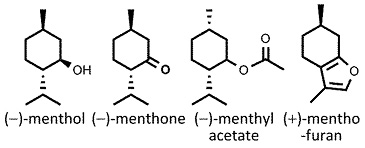 Mentha piperita
Mentha piperita
peppermint
Back to “Salad herbs and herb mixtures: peppermint (Mentha piperita)”
Back to “Culinary herbs: peppermint (Mentha piperita)*”
Mentha ×piperita L. (Lamiaceae); peperment (Afrikaans); la bo he (Chinese); menthe poivrée (French); Pfefferminze (German); gamathi pudinah (Hindi); pepaa minto (Japanese); menta piperina (Italian); hortela-pimenta (Portuguese); menta piperita (Spanish); bac hà (Vietnamese)
DESCRIPTION The leaves are dark green with a reddish purple tinge, and have a characteristic peppermint smell.
THE PLANT An aromatic perennial herb with spreading stems and lilac-pink flowers borne in elongated clusters on the stem tips. A form with larger leaves, rounded flower clusters and a distinct lemon smell is known as bergamot mint, orange mint or eau de cologne mint (M. ×piperita var. citrata). Peppermint is similar to field mint (corn mint, Japanese mint, pudinah – M. arvensis) but this important mint of Asian cuisines has axillary clusters of flowers (not terminal spikes as in peppermint and spearmint).
ORIGIN Peppermint is a cultigen and hybrid between water mint (M. aquatica) and spearmint (M. spicata) that originated in England in the 17th century.1,2 Corn mint is indigenous to Europe and Asia.1,2 The distinct difference between these two mints is clearly shown in the photographs.
CULTIVATION Plants are propagated with the greatest of ease from stem cuttings or by division and can be planted in a sunken box or pot to contain excessive spread. Peppermint tolerates shade and cold winters but corn mint is adapted to warm and tropical conditions. Peppermint is grown on a large commercial scale the Midwest of the United States for peppermint oil, while Japanese peppermint oil is produced in Japan from a selection known as corn mint (M. arvensis var. piperescens).1,2 Peppermint with its menthol flavour has become the basis of a large industry.
HARVESTING Fresh leaves are harvested at any time for culinary purposes. To produce menthol-rich essential oil, flowering stems (of both peppermint and corn mint) are harvested mechanically and extracted by steam distillation.2,3
CULINARY USES Peppermint herb and oil are used to flavour chocolates, puddings, ice creams, jellies, confectionery and beverages (e.g. crème de menthe).2,3 Peppermint leaves are used to some extent in cooking (soups, stews and vegetables) but spearmint (or field mint) is usually preferred. Bundles of field mint are a common sight at oriental fresh produce markets. Field mint is an important ingredient in Chinese, Indian, Japanese, Malaysian and Thai cuisines. Fresh leaves are used as herbal tea and ingredient and garnish in salads. It sometimes replaces the laksa plant (Persicaria odorata) as main ingredient in laksa (Malaysian noodle soup).
FLAVOUR COMPOUNDS The distinctive flavour of peppermint and field mint is due to menthol, which causes a cooling sensation.1,4 Peppermint yields 1–3% essential oil rich in menthol (30–50%) and menthone (15–33%), with some menthyl acetate and menthofuran.4 Corn mint contains 75–90% menthol and is an industrial source of this flavourant. The oil is cooled to near freezing temperature, causing the menthol to crystallize.4 The residue (known as dementholised corn mint oil) still contains 55% menthol, with menthone and menthylacetate.4 (–)-Menthol is the only one of four isomers that can bind to the proteins of cold-sensitive receptors in mammalian mucous membranes, causing the unusual cooling effect.

NOTES Peppermint oil is mostly used to flavour toothpaste, oral hygiene products, chewing gum, sweets, lozenges and cough syrups.3,4
1. Lawrence, B.M. 2007. Mint: The genus Mentha. CRC Press, Boca Raton.
2. Mabberley, D.J. 2008. Mabberley’s plant-book (3rd ed.). Cambridge University Press, Cambridge.
3. Farrel, K.T. 1999. Spices, condiments and seasonings. Aspen Publishers, Gaithersburg, USA.
4. Harborne, J.B., Baxter, H. 2001. Chemical dictionary of economic plants. Wiley, New York.